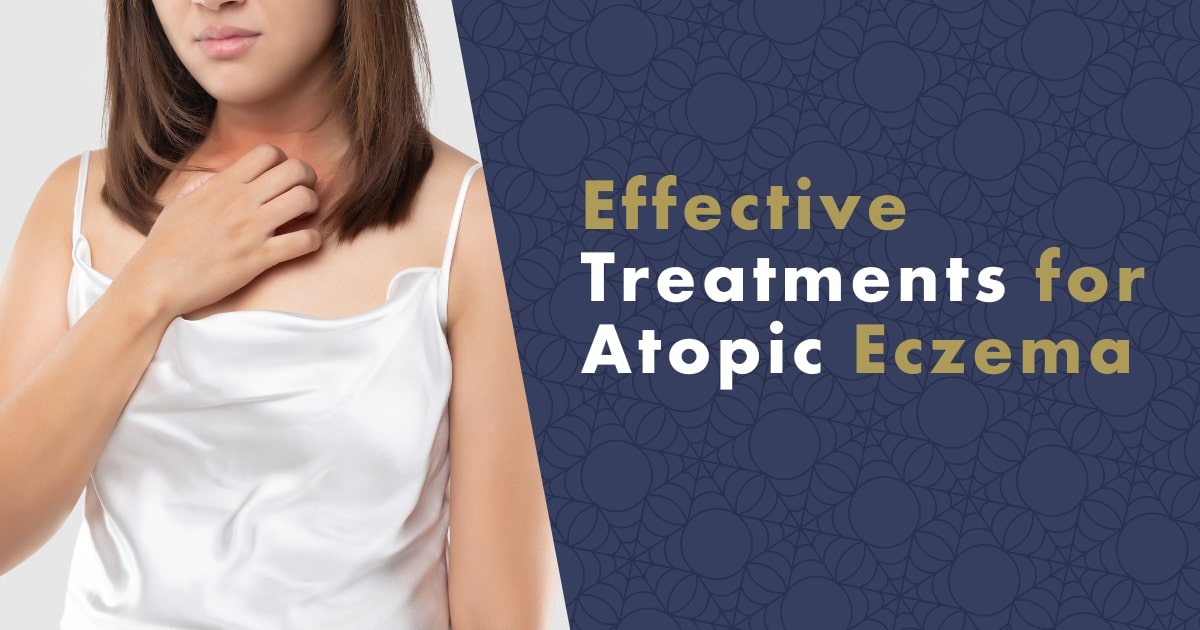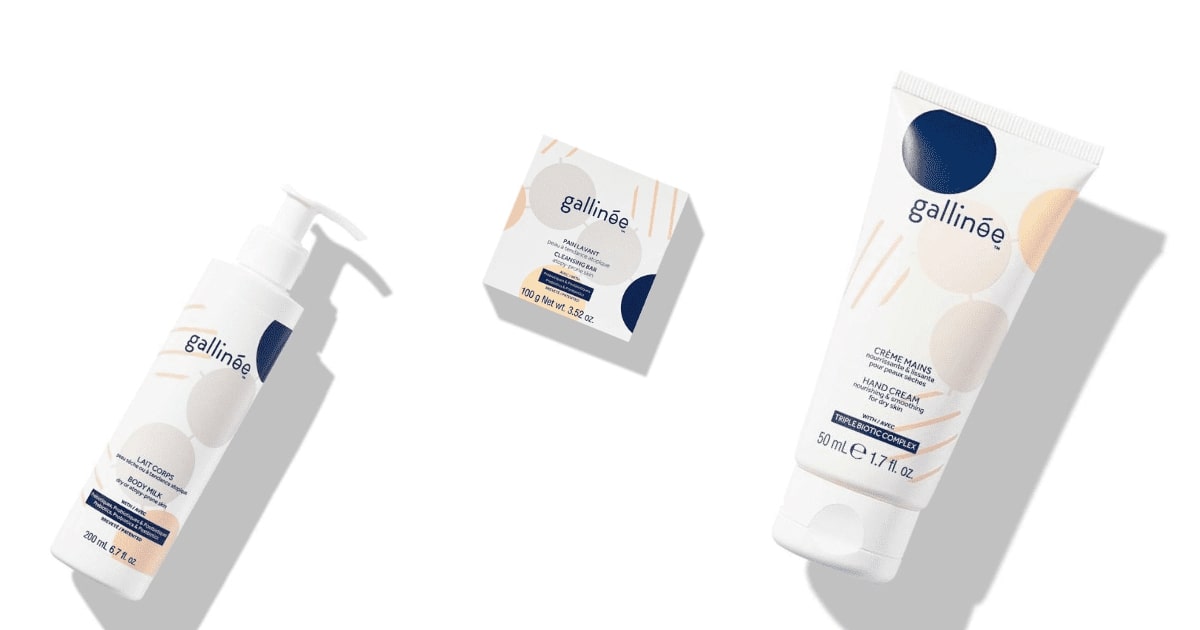Although atopic eczema cannot be completely cured, if you follow basic principles, you can alleviate its symptoms or extend periods of calm. Today we will look at how to avoid triggers and take the best care of the skin of an atopic person.

What Is Atopic Eczema?
Atopic eczema is a chronic, inflammatory skin disease that often occurs in children. It is characterized by redness, itching, and flaking of the skin. The exact cause of atopic eczema is not known, but it is believed to be associated with genetic factors and an impaired skin barrier function.
Treatment of atopic eczema focuses on relieving symptoms and preventing flares. This may include the use of moisturizers, topical corticosteroids, and other medications. In severe cases, immunosuppressive drugs or light therapy may be used. It is also important for individuals with atopic eczema to avoid triggers, such as certain soaps, detergents, and environmental irritants.
Additionally, some studies have shown that probiotics may be beneficial for individuals with atopic eczema. Probiotics are live microorganisms that are similar to the beneficial bacteria found in the human gut. They may help restore the balance of bacteria in the skin and improve symptoms of atopic eczema.
What Are the Symptoms of Atopic Eczema?
The extent of the condition varies from person to person - it appears on the forehead, eyebrows, neck, trunk, but also on the hands and feet. Especially in the calf and elbow crease.

The Most Common Symptoms Are:
- redness
- swelling
- wetness
- the outbreak of eczema lesions
- small rashes
- sudden, episodic itching
- dry skin that loses the ability to retain water
- fine cracks in the skin are also common
How Do I Get Atopic Eczema?
Genetics and immunity are largely responsible for atopic eczema. A person with atopic eczema (atopic) has genetically determined increased sensitivity of the skin and mucous membranes to various allergens. These are commonly found around us and enter our body through the skin, respiratory tract, or digestive system.
It has long been known that allergens found in the air (house dust allergens, pollen, or animal allergens) can worsen the symptoms of atopic eczema. Recent studies have revealed a correlation between the amount of dust mites in house dust and the occurrence of atopic eczema.
In Europe, atopic eczema affects 15-20% of infants and toddlers and 12% of pre-school and school-age children. The disease is not contagious among people, but is often caused by a genetic predisposition to allergic reactions, such as asthma, hay fever, or conjunctivitis. About 50% of children who have at least one allergic parent develop atopic dermatitis.
For some children, atopic eczema disappears after a few months, while for others it lasts for years. 50% of children who suffered from atopic eczema as infants will be cured by the age of five. In some cases, atopic eczema persists into adulthood.
What Are the Complications of Atopic Eczema?
The greatest danger is scratching, which can damage the skin barrier and allow infection to enter. This can be caused by Staphylococcus aureus, infection with the herpes simplex virus, or molluscum contagiosum, which is characterized by small formations resembling warts. Similarly common infections are multiple vulgar warts. Repeated cryotherapy, local therapy, or laser removal is effective for these.
What Helps with Atopic Eczema in Adults and Children?
Inflammation of the skin can of course be treated with antihistamines, which suppress allergies and itching, and in severe cases with corticosteroids in the form of ointments. Phototherapy and photochemotherapy are used in the treatment of severe cases of atopic eczema at specialized facilities. However, this only addresses the consequences. Today, we will focus primarily on prevention.
1. Cosmetics Suitable for Atopic Eczema
During atopic eczema, the skin excessively dries out, so it is important to moisturize it regularly. Ideal are products with probiotics, which according to several studies may function as a long-term prevention of the development of atopic eczema.
One of the possible probiotic strains that may be useful in local eczema treatment is Lactobacillus rhamnosus. In a study, it was found that the use of this strain reduced the incidence of eczema in children by half. The probiotic strain is also recommended for adults with atopic eczema, who may have more difficult skin and are more susceptible to infections.

2. Avoid Dust and Mites
Dust mites can be one of the provocative factors, so it is appropriate to eliminate dust in the household.
The characteristic of atopic skin is a poor protective function of the skin. Atopics have a reduced skin barrier and their skin permanently passes substances to the organism. The barrier does not protect the skin sufficiently and it becomes sensitive (fragile).
For atopics, it is therefore extremely important to equip your bed with anti-mite bedding, which prevents contact with mites and skin. The bed is full of allergens that can trigger or worsen eczema.
We spend a lot of time in bed, and young children who suffer from atopic eczema the most often spend most of the day there. It is particularly at night that itching is the worst, when the blood has the lowest amount of cortisol, which not only acts as an anti-inflammatory, but also as an anti-itching agent.
To reduce dust mites in the air, it is also recommended to use air purifiers (read here how to choose) or an ozone generator. Ozone air purifiers effectively clean the air of mold, allergens, viruses (including COVID-19), bacteria and other triggers of atopic eczema. The advantage of an ozone generator is that it penetrates even into upholstery and other textile furniture.
How to Reduce Dust in the Household:
- Equip your bed with anti allergy and anti dust mite bedding,
- frequent dusting and use of vacuums with HEPA filters,
- buy an air purifier or regularly use an ozone generator,
- get rid of carpets, upholstery and other textiles where it can accumulate,
- remove curtains or wash them frequently,
- remove or frequently wash plush toys at higher levels
3. Avoid Inappropriate Foods
Some foods can trigger eczema, even if you don't have a proven allergy to them. If you are allergic to pollen, you may react to certain fruits and vegetables. It is also important to avoid foods that contain high levels of histamine, a substance released in the body during an allergic reaction. Foods that are high in histamine include fermented, pickled, and canned foods, alcohol, ripening cheeses, cured meats, some vegetables, and fruit.
- Fermented, pickled and canned foods,
- alcohol,
- ripening cheeses,
- cured meats,
- some vegetables, e.g. tomatoes or spinach,
- fruit, e.g. strawberries, pineapple, etc.,
- Chocolate,
- fish, seafood.
As people with atopic skin tend to be more sensitive, it is important to be cautious about additives used in the food industry, such as preservatives, dyes, and flavors.
If you have atopic eczema, it's important to pay attention to the foods you eat. Foods containing unsaturated fatty acids, such as avocado, nuts, fish, and oils, can help improve your symptoms. Foods rich in zinc, like pumpkin seeds, meat, and legumes, can also be beneficial. In addition, taking probiotics can support a healthy gut microbiome, which may help reduce the symptoms of atopic eczema. Probiotics are live bacteria that can help improve the health of your digestive system. By incorporating these foods into your diet, you may be able to improve the symptoms of your atopic eczema.
4. Choose the Right Clothes
When choosing clothing, it's important to consider how it will affect your atopic eczema. In cold weather, it's natural to want to layer up, but this can actually make your symptoms worse. Instead, look for clothing that is breathable and won't cause you to sweat. When sweat stays on your skin for too long, it can irritate your eczema. There are now many breathable materials that have high thermal regulation properties, which can help prevent sweating and keep your skin comfortable. Nanomaterials, which can regulate skin temperature, are also a good option for people with atopic eczema. By choosing the right clothing, you can help reduce your symptoms and stay comfortable.
For people with atopic eczema, extremely breathable materials are the best choice. You can try designer clothing from Lady Vyvialova, which uses materials originally developed for medical corsets used after surgeries, primarily for their lightness and antibacterial properties.
What are suitable materials for eczema sufferers:
-
Ultraleight nanomaterials for allergy sufferers
-
Cotton with antibacterial treatment
-
Silk
-
Bamboo
-
Linen
Cotton is the most recommended fabric for people with eczema, but it can be too heavy and in the summer it can cause problems. Therefore, choose cotton with antibacterial treatment.
Pay attention to where the product was made, as the dye used on clothing can also irritate you. Always wash your clothing before using it.
You can also choose silk clothing, which is less practical. An interesting alternative is bamboo, which is as soft as cotton, but slightly cooler and has some antibacterial properties.
Tight clothing does not necessarily benefit eczema, so choose pieces that do not cling so much to the body. Tight jeans with relatively aggressive dyes used on them are definitely not ideal. Looser clothing does not rub against the skin as much and is much more breathable.
Always make sure that all scratchy or hard tags are cut off from your clothing. Even if you are wearing something loose and flowing, a scratchy tag can mean an unpleasant outbreak of eczema if you do not pay attention.
5. The Right Temperature and Humidity
Especially in the winter, it is necessary to monitor the humidity of the air. Dry air dries the mucous membranes and skin and can worsen atopic eczema. The ideal air humidity is between 40% and 60%, which you can measure with a hygrometer.
In the winter, you can use a humidifier to increase the humidity in the room, but be careful not to overdo it, as excessive humidity can cause mold growth. In the summer, on the other hand, you should use an air conditioner to reduce the humidity in the room.
Always make sure that the room temperature is comfortable and not too hot or too cold. The ideal temperature is between 18 and 22 degrees. Avoid sudden temperature changes, as they can cause an outbreak of eczema.
Sources
-
Chang, Y.-S., Chiang, B.-L., & Lee, T.-H. (2014). Atopic Dermatitis, Allergic Rhinitis, and Asthma: Which One Comes First? Taiwanese Journal of Obstetrics and Gynecology, 53(1), 3-8.
-
Han, S.-H. (2019). Atopic Dermatitis. The Korean Journal of Medicine, 94(1), 1-5.
-
Hon, K.-L. E., Leung, T. F., Wong, Y., Ma, K. C., Fok, T. F., & Ng, P. C. (2019). Steroids and Antihistamines for a Child with Atopic Dermatitis: When and How to Use Them? The Korean Journal of Pediatrics, 62(1), 3-7.
-
Katsarou, A., Armenaka, M. C., & Boskou, D. (2020). Dietary Factors in Atopic Dermatitis. Current Nutrition Reports, 9(2), 82-89.
-
Kim, J. E., & Kim, J. S. (2019). Pathophysiology of Atopic Dermatitis. The Korean Journal of Internal Medicine, 34(4), 724-735.
-
Lee, S.-Y., Kim, J. Y., Kim, B. J., Kim, M. N., & Hong, J.-Y. (2019). Practical Management of Atopic Dermatitis in Adults. The Korean Journal of Medicine, 94(1), 26-35.
-
Na, S.-J., & Kim, J. H. (2018). Allergen Immunotherapy for Atopic Dermatitis. The Korean Journal of Internal Medicine, 33(5), 844-852.
-
Oh, S. H., & Han, E. C. (2018). The Role of Vitamin D in Atopic Dermatitis. The Korean Journal of Medicine, 93(3), 213-219.
-
Paller, A. S., Tom, W. L., Lebwohl, M. G., Blumenthal, R. L., Boguniewicz, M., Call, R. S., et al. (2019). Efficacy and Safety of Crisaborole Ointment, a Novel, Nonsteroidal Phosphodiesterase 4 (PDE4) Inhibitor for the Topical Treatment of Atopic Dermatitis (AD) in Children and Adults. Journal of the American Academy of Dermatology, 80(3), 624-631.
- WIECZFIŃSKA, Joanna; PAWLICZAK, Rafał. The impact of commercially available air purifiers on bronchial asthma and allergy symptoms. Alergologia Polska-Polish Journal of Allergology, 2022, 9.1: 49-54.
-
Sweeney, C. M., O'Sullivan, M., & Clayton, N. (2019). Atopic Dermatitis: A Review of Diagnosis and Treatment. American Family Physician, 100(4), 239-248.

